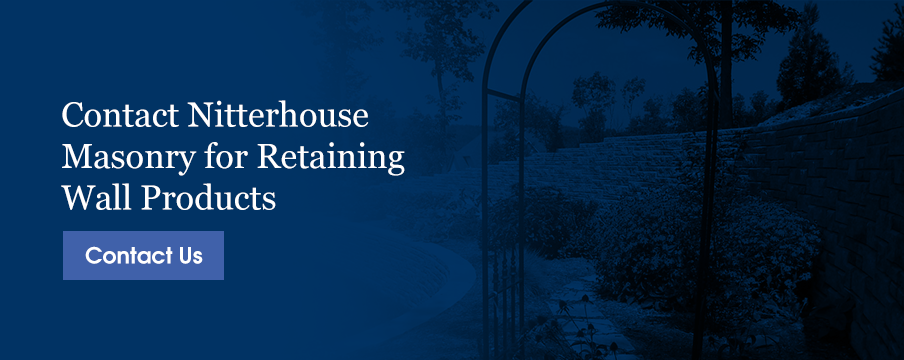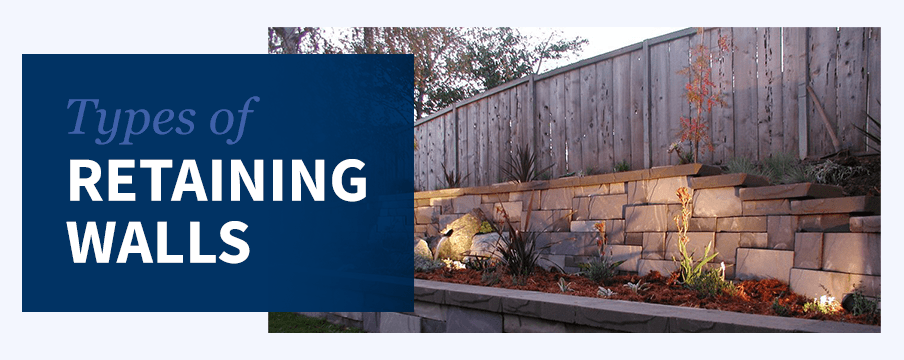
Jump-To:
- What Is a Retaining Wall?
- Why Should I Build a Retaining Wall?
- Gravity Retaining Wall
- Cantilevered Retaining Wall
- Piled Retaining Wall
- Anchored Retaining Wall
- Retaining Wall Materials
Retaining walls can be a beautiful, functional addition to any landscape. They can offer a chance to use more outdoor space or add a dynamic feature to your garden. With so many retaining walls to choose from, the styles, colors and varieties are endless.
However, there are several things to consider when deciding which type of retaining wall is best for you. Ask yourself:
- How tall does the wall need to be?
- What material is best? What’s my budget?
- If I’m building the wall on a slope, how steep is it?
- Will the wall be curved or straight?
- How will I allow for drainage?
- What style of wall should I install?
To begin answering these questions, you will first need to learn about how a retaining wall works and what differentiates the various types. To make sure you’re installing the best wall for your project, we’ve created a guide to help answer some of your questions.
What Is a Retaining Wall?
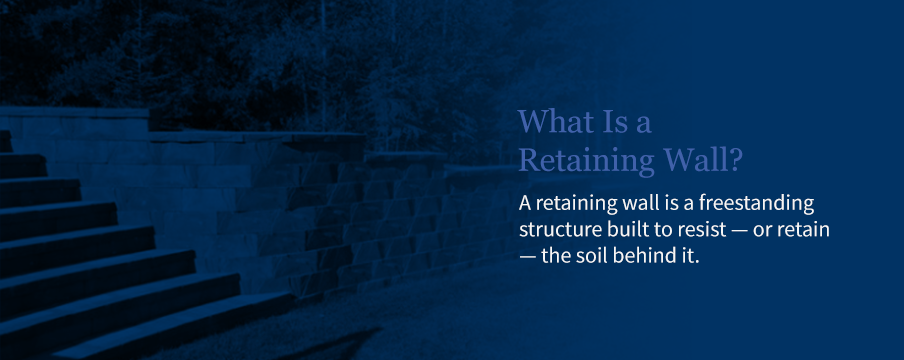
A retaining wall is a freestanding structure built to resist — or retain — the soil behind it. It’s only possible to pile earth to a specific angle without slumping — experts refer to this as the angle of repose. When the desired change in ground elevation is higher than the angle of repose, a retaining wall is a solution.
A retaining wall supports a “wedge” of soil. The wedge consists of all the soil from the retaining wall to the plane at which it would naturally lie without the wall, also known as the failure plane. To decrease the amount of pressure on a wall, landscapers increase its setback, or the degree to which the wall tilts toward the soil. As the setback increases, the wedge decreases, reducing the pressure on the wall.
Depending on the height of the wall and the slope of the soil, retaining walls can support an enormous amount of pressure, so it’s crucial to ensure proper construction. Whether you’re building one to prevent a hill from eroding, or to maximize garden space on a sloped part of your property, there are a few things to consider before you install a retaining wall.
Drainage
Since retaining walls convert sloped surfaces into flat ones, they tend to collect rain and irrigation water. When water accumulates behind a retaining wall, the lateral pressure of the soil increases, putting more weight on the wall. Without proper drainage, this water can cause the wall to bloat, crack or fail.
To prevent this from happening, you’ll need to implement specific drainage measures.
- Weep holes: Weep holes are small horizontal holes drilled in regular intervals throughout the wall. As water collects behind the wall, it can escape through the holes, relieving the pressure.
- Perforated drainage pipe: Perforated drainage pipes are near the bottom of the wall, buried in the soil. The drainage pipe has several holes drilled around its circumference, so it can catch water as it trickles down through the soil.
- Granular soil: You can also use granular soil to help the water move more freely toward the drainage pipe and weep holes. Since granular soil has coarse grains and no cohesive strength, it allows other drainage systems to effectively collect water and expel it from the area.
Height Limitations
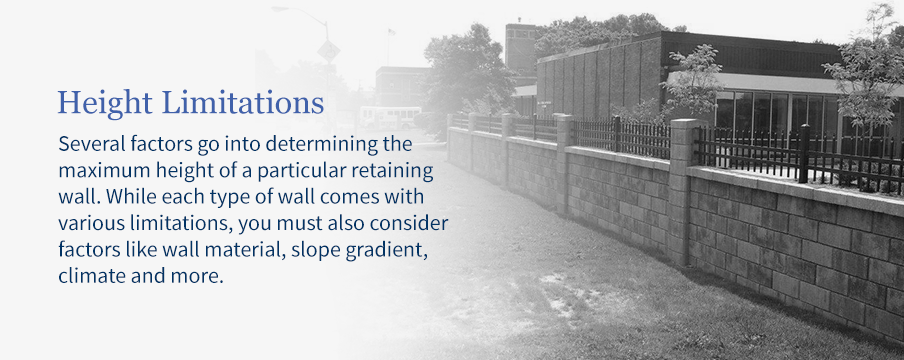
Several factors go into determining the maximum height of a particular retaining wall. While each type of wall comes with various limitations, you must also consider factors like wall material, slope gradient, climate and more. To find out the height limitations for your retaining wall project, always consult with a professional mason or contractor. A retaining wall that’s too high can be susceptible to cracks and breaks, so it’s essential to consult with an expert before you start any project.
You should also be aware of any laws in your area that limit your ability to build a retaining wall. Some states only allow professional contractors and masons to construct retaining walls above a specific height. Since building a retaining wall typically involves digging into the ground, you should also call 811 before you begin your project. They’ll tell you if there are any utility lines on the property to avoid.
Wall Engineering
No matter what type of retaining wall you choose for your project, you should understand the importance of engineering your wall. Despite their simple appearance, a retaining wall is a sophisticated structure that’s resisting the power of gravity at every moment. As the name implies, a retaining wall keeps soil from following its natural slope and eroding away. Wall failure can ruin your curb appeal and can even result in lawsuits. It’s vital to have your wall engineered and installed by a certified retaining wall contractor. Several factors might warrant the need for a licensed engineer.
- Wall height: Most municipalities require permits and a licensed engineer for any wall over four feet. You should consult local building codes in your area, or a retaining-wall-certified contractor, to determine the exact wall height rules regulating your construction.
- Parking lots: If you’re using a retaining wall to shape a parking lot, the structural integrity becomes even more critical. The weight of vehicles driving on the parking lot can put added stress on a retaining wall. An engineer can ensure your retaining wall is structurally sound.
- Gravity wall: If the wall’s weight, rather than mortar, keeps it intact, you should consult a licensed engineer. The precise angles of setbacks and sliding wedges will keep your wall firmly in place with sound engineering.
If you are unsure if you need an engineered retaining wall, the best course of action is to consult a licensed engineer.
Why Should I Build a Retaining Wall?
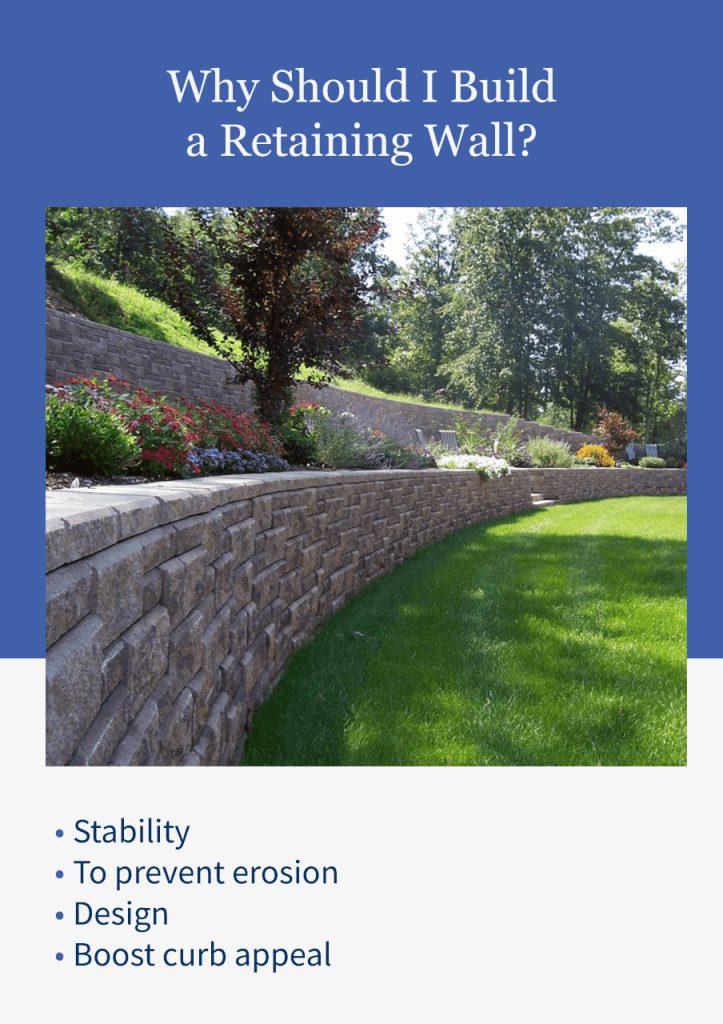
Retaining walls come with a variety of advantages, but the installation process can be an elaborate and expensive endeavor. Before you invest your time and money in a retaining wall, consider the most common reasons for building them.
- Stability: If you’re looking to build a deck or garden, installing a retaining wall will help even out and stabilize the land. Maintaining a garden on a sloped landscape is challenging, and it can lead to the soil loosening and falling downward.
- To prevent erosion: When rain or irrigation water repeatedly flows across sloped soil, it slowly erodes. Retaining walls can slow or even halt this process, as they make the landscape even and decrease the flow of water.
- Design: Aside from their functional purposes, retaining walls can also be purely aesthetic. They can add interesting features and stunning designs throughout a property. You can use them to add a terrace to the backyard, carve out a patio or create a driveway.
- Boost curb appeal: A well-placed retaining wall adds a level of elegance and sophistication to your landscape. If you’re looking to sell, a retaining wall can help boost the look of your landscape and the overall value of your home.
Gravity Retaining Wall
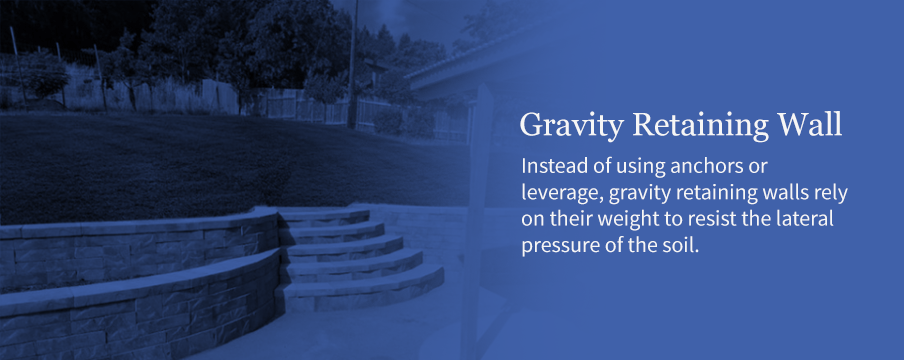
Instead of using anchors or leverage, gravity retaining walls rely on their weight to resist the lateral pressure of the soil. They can consist of concrete, stone or bricks, and are generally the thickest type of retaining walls. The construction of shorter gravity walls usually involves segmented concrete units or mortarless stone.
Gravity walls often have a degree of setback, meaning they tilt slightly backward into the soil, to offer further stability and support.
At Nitterhouse Masonry, we offer a variety of gravity walls, including the Allen Block Europa Collection. These blocks provide a timeless elegance to any landscape, with their natural, weathered appearance. Each block features a hollow core that makes them easy to handle and promotes good drainage behind the wall. They come in many shapes to create a patterned wall and a variety of colors to fit any aesthetic. Unlike solid poured walls or blocks that require adhesive to hold them together, it’s possible to dismantle and reuse these modular blocks.
What Are the Benefits of Gravity Walls?
Gravity retaining walls are the most common and preferred option because they offer a wide range of benefits.
- Easy installation: If you’re using concrete blocks, stone or bricks to build your gravity retaining wall, the installation process is relatively straightforward. The process requires no pins or mortar, but rather depends on gravity and a lip on the edge of the stones to stay in place.
- Durable: A correctly installed gravity retaining wall can last for decades with minimal maintenance. The sheer size and weight of the wall allow it to withstand freezing and thawing without cracking.
- Design options: Gravity walls are one of the most versatile options among retaining walls. You can tailor the wall to your needs, making it look sleek and modern or rustic and natural. You can also build them to form stairs, corners or curves, and stain them to match the style and look of your property.
- Good for tight spaces: One common use for gravity retaining walls is to expand the usable space of shorelines, residential subdivisions or storm channels. These areas can have limited usable space because of hills or slopes, and gravity retaining walls can help level the landscape.
Cantilevered Retaining Wall
Cantilevers are a type of reinforced retaining wall that uses leverage to resist the lateral pressure of the soil. Cantilevered walls usually consist of solid slabs of concrete, reinforced with steel. They can be either precast in a factory or formed on site.
They are usually L-shaped or T-shaped and consist of a thin stem and a base slab. There are two parts to the base: the heel, which sticks out into the supported soil, and the toe, which sticks out in the opposite direction. Their unique design allows them to convert the horizontal pressure pushing on the wall into vertical pressure in the ground.
Buttress vs. Counter-Fort
For extra strength and support, cantilevered walls sometimes include counter-forts or buttresses. Both are vertical beams that attach to the base slab, but their placement determines their name. If the beams connect to the back of the wall, or heel, it’s called a counter-fort wall. If the beams connect to the front of the wall, or toe, it’s called a buttress wall.
What Are the Benefits of Cantilevered Walls?
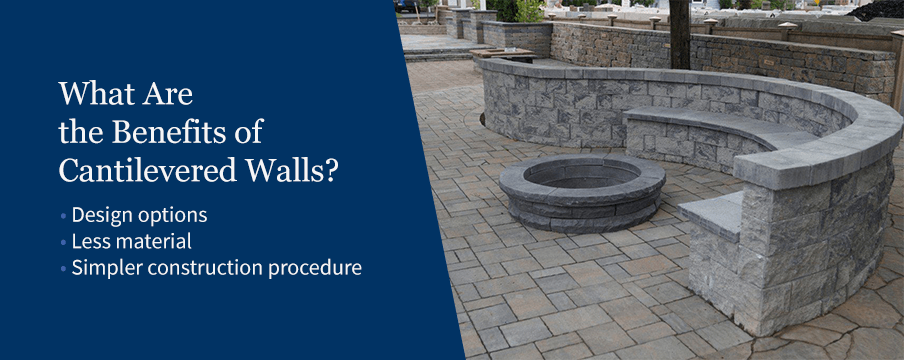
Cantilevered walls are another popular type of wall because they offer a variety of advantages.
- Design options: Concrete isn’t always the most attractive, so many people cover concrete cantilevered walls with a decorative material. You can apply any durable facing material to the concrete to give it a look that matches the rest of your landscape.
- Less material: Solid cantilevered walls generally use less concrete than solid gravity walls. However, cantilevers require more design and planning.
- Simpler construction procedure: Cantilevered walls have a more straightforward construction technique, compared to other wall types. Instead of building the wall block by block at the site, builders mold them into the correct shape and put them into place.
Piled Retaining Wall
Piled walls are another retaining option for holding back soil and earth. For this method, landscapers use long piles to secure the structure deep in the ground, allowing them to withstand a significant amount of lateral pressure. The most common type of piling retaining wall is sheet piling.
Sheet piling is the thinnest retaining wall. However, they can still support a significant amount of weight because they typically consist of steel or reinforced concrete. Their installation method deep within the ground helps them stay in place without taking up much space.
What Are the Benefits of Piled Walls?
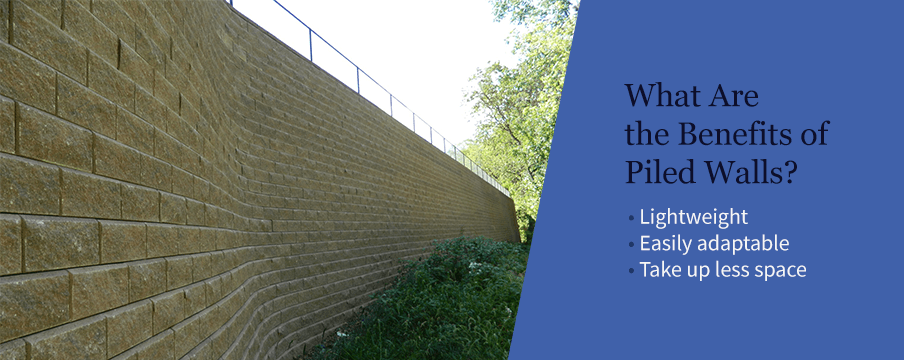
While piled walls aren’t as popular as gravity or cantilevered walls, they offer a unique range of advantages.
- Lightweight: Because piled walls depend on the ground below to secure the retainer, they are much lighter than other materials. Their weight makes them exponentially easier to transport and install.
- Easily adaptable: Welding or bolting is a straightforward way to extend the length of each pile. They can adapt to curves and corners.
- Take up less space: Since this type of wall doesn’t rely on weight or leverage to stay in place, it takes up a minimal amount of space. If you don’t have a lot of room for your retaining wall, a piled wall might be the best choice.
Anchored Retaining Wall
It’s possible to build anchored retaining walls in any of the previously described styles, but they must also have an additional tieback anchored in the soil behind the wall. This approach is especially helpful when the wall needs to support a significant amount of lateral pressure.
The anchor normally gets inserted into the wall, then expanded through mechanical means or by injecting pressurized concrete that expands and forms a bulb in the soil.
What Are the Benefits of Anchored Walls?
Anchors are a popular addition to any retaining wall for the following reasons.
- Provide more resistance: Any retaining wall can crack or break under the pressure of the soil from age or poor installation. Anchoring the wall is an approachable way to make sure it stays up for a long time.
- Allow for thinner or lighter walls: If you’ve got limited space or budget, you can use anchors to increase the strength of lighter or thinner walls.
Retaining Wall Materials
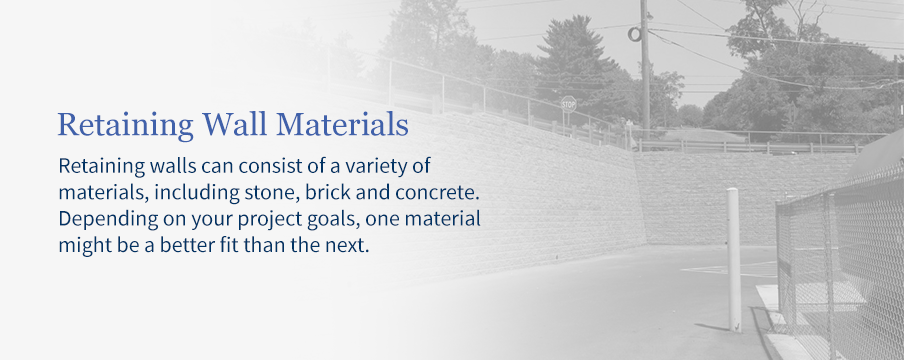
Retaining walls can consist of a variety of materials, including stone, brick and concrete. Depending on your project goals, one material might be a better fit than the next. To find out which will be the best choice for your wall, you’ll first need to understand the differences between them.
Each retaining wall material has unique benefits, disadvantages and styles. We’ll review the most common materials below.
Stones and Bricks
As long as your stone or brick retaining wall has sufficient drainage, it will be an excellent, long-lasting option. Only an experienced mason should install these types of walls, since the process is so technical. Stones and bricks offer a wide range of colors and styles, so you’ll be able to get whichever shape or look you want.
Concrete Blocks
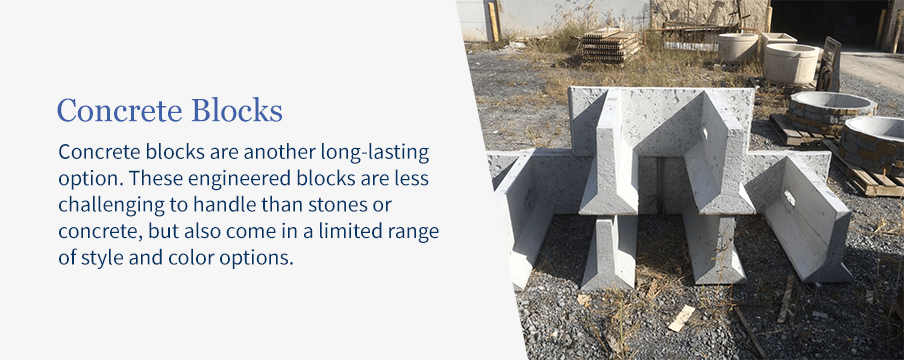
Concrete blocks are another long-lasting option. These engineered blocks are less challenging to handle than stones or concrete, but also come in a limited range of style and color options. While you might be able to install short concrete block retaining walls as a DIY project, you should hire a professional to complete taller ones.
At Nitterhouse Masonry, we offer the Forix Block, an innovative concrete precast modular block for building retaining walls. The blocks are larger than competing varieties, yet are efficiently engineered and have an economical weight. The Forix Blocks feature:
- Triangular rear legs that allow for an arching effect with the addition of stone backfill, resulting in downward force on the blocks
- Less weight and fewer manufacturing costs than other precast, solid concrete wall blocks
- Free draining and a stone infill
- Geogrid reinforcement that allows taller walls than conventional gravity walls
- Vertical alignment control from lugs on the bottom of the units
The Allan Block Retaining Wall Collection, our most popular option, is another fantastic option for concrete blocks. They create a classic, professional look with clean edges. With this collection, you also have the opportunity for a patterned wall design because the blocks are modular. We offer the Allen Block Retaining Wall Collection in a variety of natural stone color options. These blocks dry-stack for easy installation and are perfect for a project of nearly any size.
Contact Nitterhouse Masonry for Retaining Wall Products
Building a retaining wall can be a long and challenging process. Without the best materials, your wall can crack, bulge or even crumble completely. If this happens, you’ll have an even more expensive and time-consuming project on your hands.
To make sure your retaining walls stand the test of time, use Nitterhouse Masonry products. For 25 years, we have proudly been producing high-quality Allan Block concrete engineered block systems. We offer a full range of concrete block retaining wall options that don’t require mortar, allowing for any style, shape or design.
At Nitterhouse Masonry, we also offer a variety of other services, including:
- Residential exteriors
- Residential interior applications with veneer stone and brick
- Commercial exterior applications: health care facilities, office buildings, schools, dorms, fire stations
- Residential and commercial retaining walls
- Commercial and residential patios, walkways, parks, commercial roof pavers
To learn more about our services and products, contact or call us at 717-267-4500 today for your next retaining wall project.


